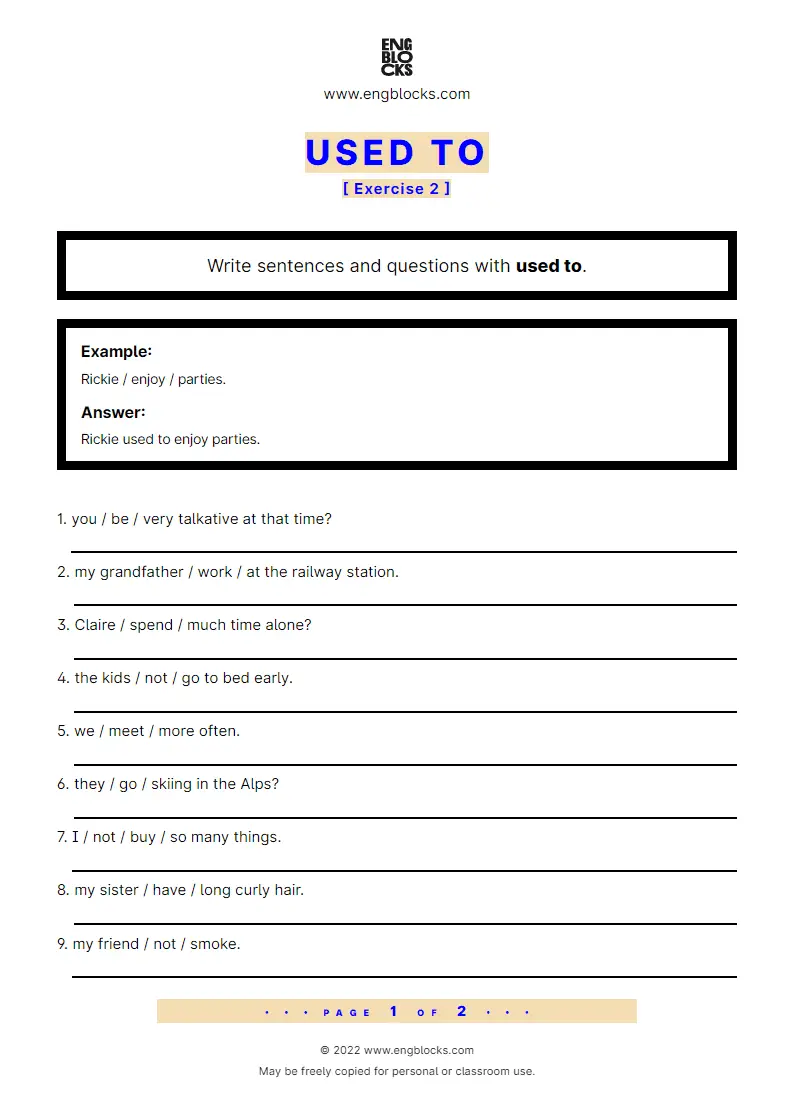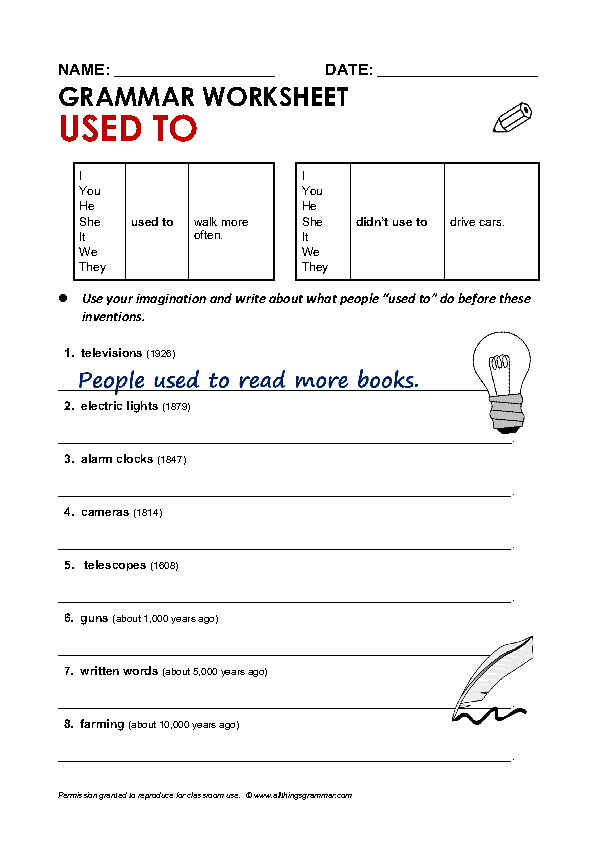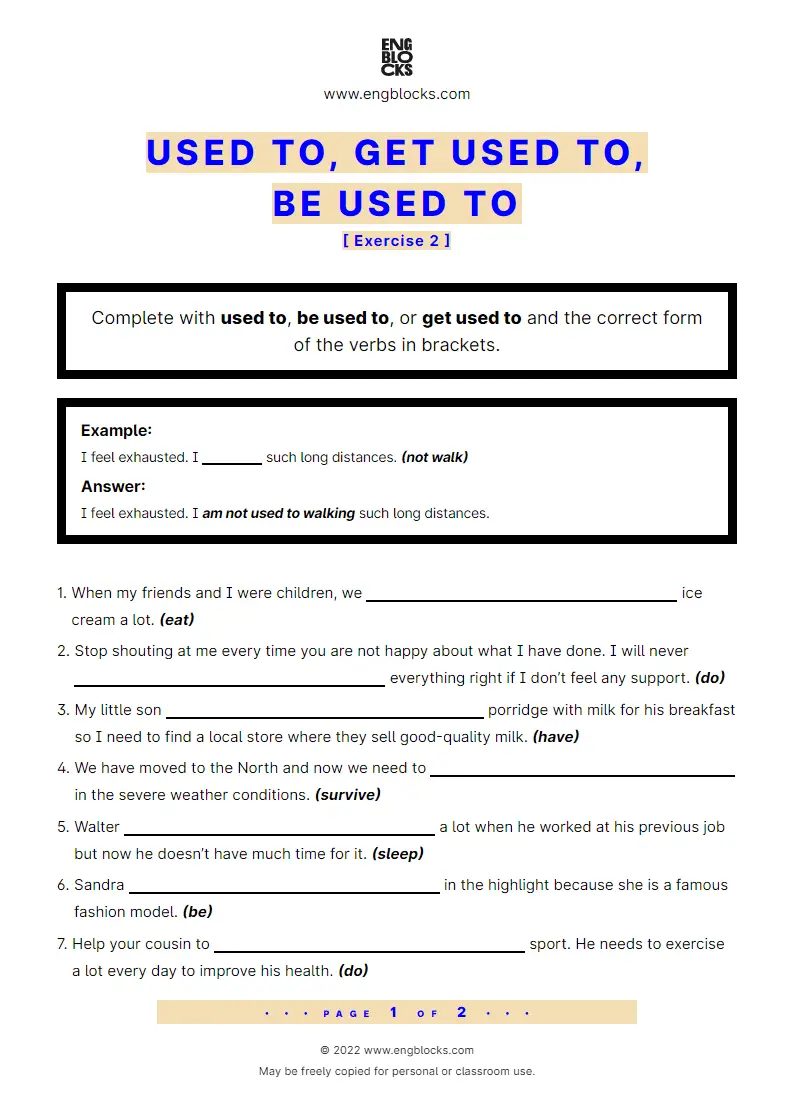
Mastering the Past: The Indispensable Role of Grammar Worksheets: Used to
English grammar, with its intricate tenses and nuanced expressions, often presents a considerable challenge for learners. Among the many grammatical structures, the phrase "used to" stands out for its unique function in describing past habits, states, or situations that no longer hold true. While seemingly straightforward, its correct application, especially in negative and interrogative forms, frequently trips up even intermediate learners. This is precisely where the power of targeted practice comes into play, and Grammar Worksheets: Used to emerge as an indispensable tool for solidifying comprehension and promoting accurate usage.
The Significance of "Used To" in English
Before delving into the pedagogical benefits of worksheets, it’s crucial to understand why "used to" is such a vital component of English communication. This structure allows speakers and writers to convey a sense of nostalgia, change, or contrast between the past and the present. For instance, saying "I used to live in a small town" immediately tells the listener that the speaker no longer resides there. Similarly, "My grandmother used to bake delicious cookies every Sunday" paints a picture of a regular past activity that has since ceased.

The common pitfalls associated with "used to" include confusing it with "be used to" (meaning accustomed to) or "get used to" (meaning to become accustomed to). Furthermore, students often struggle with the correct form in questions ("Did you use to…?") and negatives ("I didn’t use to…"), mistakenly retaining the "d" from "used" in these contexts. These persistent errors highlight the need for repetitive, focused practice that Grammar Worksheets: Used to are perfectly designed to provide.

The Pedagogical Power of Worksheets

Worksheets, in general, serve as a bridge between abstract grammatical rules taught in a classroom and the practical application of those rules. For a structure like "used to," which requires both form mastery and contextual understanding, worksheets offer a structured environment for learners to experiment, make mistakes, and correct them.

The utility of Grammar Worksheets: Used to extends far beyond simple drilling. They cater to various learning styles: visual learners benefit from seeing the patterns written out, kinesthetic learners can engage by writing and manipulating sentences, and logical learners can decipher the rules through repeated exposure to examples. They provide a tangible record of progress, allowing both students and teachers to identify areas of strength and weakness. Moreover, in an era where self-paced learning is increasingly common, well-designed worksheets empower students to practice independently, reinforcing concepts learned in class or from textbooks.

Types of Effective Grammar Worksheets: Used to Exercises
To be truly effective, Grammar Worksheets: Used to should incorporate a variety of exercise types that progressively challenge the learner. Here are some key formats:
-
Fill-in-the-Blanks: This is the most basic and foundational exercise. Students are given sentences with a blank where "used to" or its negative/interrogative form should be placed.

- Example: "When I was a child, I __ (play) outside every day."
- Benefit: Reinforces the basic structure and conjugation.


-

Sentence Transformation: This type requires students to convert sentences from the simple past tense to "used to" or vice versa, and sometimes to transform affirmative statements into questions or negatives.
- Example: "He played football every Saturday." -> "He used to play football every Saturday."
- Example: "She didn’t like vegetables when she was young." -> "Did she use to like vegetables when she was young?"
- Benefit: Develops flexibility in applying the structure and understanding its relationship with other past tenses.
-
Error Correction: Presenting sentences with common mistakes related to "used to" (e.g., "He didn’t used to go," "Did you used to lived") forces students to actively identify and correct errors.
- Example: "Find the mistake: My brother didn’t used to watch much TV."
- Benefit: Directly addresses common misconceptions and reinforces correct forms.
-
Matching Exercises: Students might match a past habit described with "used to" to a contrasting present reality.
- Example: Match Column A (Past) with Column B (Present):
- A: I used to have long hair.
- B: Now I have short hair.
- Benefit: Emphasizes the contrastive nature of "used to" and enhances contextual understanding.
- Example: Match Column A (Past) with Column B (Present):
-
Contextualized Scenarios/Story Completion: Providing a short paragraph or a set of prompts about a character’s past and present encourages students to use "used to" naturally within a narrative.
- Example: "Complete the story about Sarah’s childhood: When Sarah was little, she lived in the countryside. She used to ____. She also didn’t use to ____."
- Benefit: Promotes communicative use and integrates grammar into broader language skills.
-
Personal Reflection/Interview Prompts: Asking students to write about their own past habits using "used to" or to interview a partner about theirs makes the grammar point highly relevant and engaging.
- Example: "Write three things you used to do as a child but don’t do now."
- Benefit: Encourages authentic expression and personal connection to the language.
Designing and Implementing Effective Grammar Worksheets: Used to
When creating or selecting Grammar Worksheets: Used to, several pedagogical principles should guide the process:
- Clarity and Simplicity: Instructions should be unambiguous, and the layout clean. Overly cluttered worksheets can overwhelm learners.
- Variety: As mentioned, mixing exercise types keeps students engaged and targets different aspects of understanding.
- Contextualization: Grammar should not be taught in isolation. Worksheets should present "used to" within relatable scenarios, short stories, or dialogues to give it meaning.
- Progression: Start with simpler exercises (e.g., fill-in-the-blanks) and gradually move to more complex, communicative tasks (e.g., personal narratives, role-plays).
- Feedback Mechanism: Worksheets are most effective when coupled with timely and constructive feedback. This could involve self-correction using an answer key, peer correction, or teacher review. The goal is not just to get the answer right but to understand why it’s right.
- Integration with Other Skills: While worksheets focus on grammar, they can be designed to lead into speaking activities (e.g., "Discuss your answers with a partner"), listening (e.g., "Listen to an audio and complete the sentences"), or writing tasks.
- Differentiation: Consider providing different levels of challenge within the same worksheet or offering separate worksheets for varying proficiency levels in a mixed-ability class.
Benefits for Learners and Educators
For learners, well-crafted Grammar Worksheets: Used to offer:
- Confidence Building: Successful completion of exercises instills a sense of achievement and encourages further learning.
- Accuracy: Repetitive practice helps internalize the correct forms, reducing common errors.
- Retention: Active engagement with the material, rather than passive listening, improves memory and long-term retention.
- Self-Assessment: Students can identify their own areas of difficulty and focus their efforts.
- Independent Practice: Worksheets facilitate learning outside the classroom setting.
For educators, these worksheets are invaluable because they:
- Provide Structured Practice: They offer ready-made exercises that align with lesson objectives.
- Save Time: Teachers don’t have to create every practice activity from scratch.
- Allow for Assessment: Worksheets serve as a quick gauge of student understanding and can highlight areas needing further instruction.
- Facilitate Differentiation: Easily adaptable to suit various student needs.
- Supplement Instruction: They reinforce concepts introduced in lessons, ensuring ample exposure and practice.
Conclusion
In the journey of mastering English grammar, "used to" represents a significant milestone, unlocking the ability to discuss past realities with nuance and clarity. While classroom instruction lays the groundwork, it is the consistent, focused practice that truly solidifies understanding and promotes fluent, accurate usage. Grammar Worksheets: Used to are far more than mere busywork; they are strategically designed tools that empower learners to actively engage with the language, overcome common hurdles, and ultimately achieve communicative competence. By embracing a variety of exercise types, ensuring clear instructions, and providing meaningful feedback, educators can harness the full potential of these worksheets to transform a challenging grammatical concept into an accessible and enjoyable learning experience.
